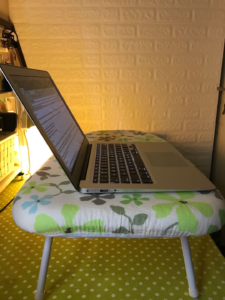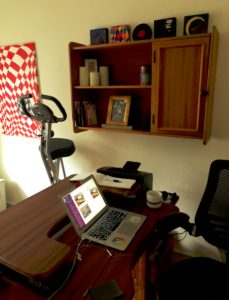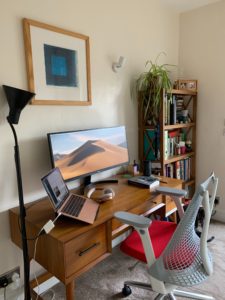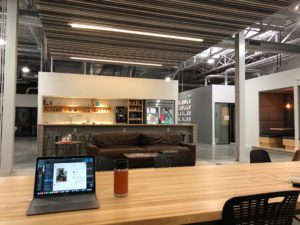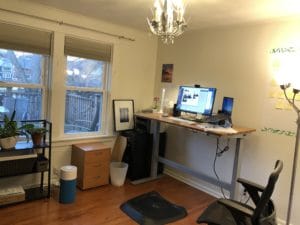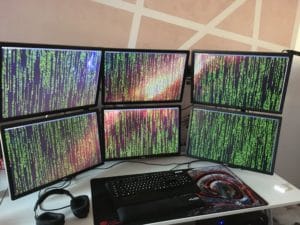Subscribe to our newsletter
Working remotely at Digital Science – tips from across the globe
With the majority of our colleagues working remotely worldwide, across 23 different countries and almost all timezones, we wanted to share some useful tips, advice and anecdotes about what it’s like to work from home and how best to be creative within the confines of your home. We’ll be sharing four personal stories over the course of the next week, with Judy’s story of what it’s like to work in full lockdown for six weeks starting things off today.
Many organisations are now faced with a situation where remote working is the only option and it can present a host of new challenges. You may feel like you have no control over the situation or find that gaining a trust level with a remote team can be a bit of a challenge.
As a geographically dispersed company with many remote staff, we thought it might be useful to share some hints and tips as to how we build and retain strong teams. We also asked staff from around the world what they found most useful and how they create routines and office spaces in their homes, and will be featuring a different employee over the coming days.
We would love to hear about your own remote working tips. Get in touch at @digitalsci using the hashtag #DSCommunity
Judy Bai, Director of Business Development at Digital Science is based in the Shanghai office and spent the best part of six weeks under lockdown working from home. Judy is our first staff member to share her experiences and certain improvisation skills in lieu of a laptop stand.
“We’ve been practicing working from home for over a month now. I don’t have a laptop stand at home but managed to figure out an alternative – a mini iron board, which is just about the right height. I sometimes would also have informal catch up calls while walking around the neighbourhood.
“At the beginning of the lockdown, there’s lots of uncertainty on how long it would take to get over the COVID-19 outbreak. After six weeks, the situation in Shanghai is becoming slightly more normal and some colleagues have started coming back to the office.
“During the first week, I constantly monitored the COVID-19 dashboard and hoped to see the signs of a tipping point. It soon became clear that it would take a lot longer than expected, just as the saying says ‘Diseases come on horseback but go away on foot’.”
“It will all get better with time and so I stopped worrying about the numbers. And after a couple of weeks, I’m kind of starting to get used to working from home.”
On Monday, we’ll hear from Overleaf’s Tim Alby, who’ll share tips on the ‘art of commuting at home’ and the importance of physical activity.
We’d also like to share an extensive list of tips from company level for those who are interested. Read on if systems and programmes, tools, wellbeing and team building are your thing.
SYSTEMS AND PROGRAMMES
- Securely share all work related documents in the same shared drives and cloud-based workspace, and ensure that folders are used to group documents
- Use collaborative writing and editing tools. We use Google Docs, Sheets, etc. If you are writing a paper, overleaf has the functionality for many people to collaborate at the same time
- Replace the feeling of walking up to someone’s desk and asking them a question by using messenger apps – we discuss our use of Slack in the Team Building section below
- Consider the core hours that work for your team, based around their time zones, additional commitments around childcare, etc. For example, Overleaf’s core hours are 2pm to 5pm UK-time, as this covers the tail end of the day for those in the East, and the morning for those in the West. The team organise large meetings in these times to ensure that people can attend
- Work flexibly around your commitments if at all possible, and if your organisation can accommodate this. It helps here to manage expectations so that people know when they might hear back from you. This can be achieved in a few simple ways, such as using your Out of Office responses to explain when your working hours are, updating your status on Slack to say when you are working or whether you are focusing on something else, and adding a line in your email signature; for example, John Hammersley, the founder and CEO of Overleaf, has a line in his email signature that states that his working hours may not be your working hours, as he has children and works around them. By stating that he does not expect a response when he sends an email sets a healthy and inclusive tone for his colleagues and collaborators
- We use Google Hangouts for team meetings and Zoom for larger meetings. For large meetings, it is important to stick to your meeting basics – send an agenda in advance, assign a chair and a note taker, and try, if you feel comfortable, to be on video, so that your colleagues can see you. If your bandwidth is suffering under the strain of the video part, try and be visible for at least the start of the meeting before switching your camera off
- Keep track of the work that you and your colleagues are doing using project management tools such as Monday.com and Trello. This also means that others know where you are with a project and can find all the relevant files if you happen to be off sick or tied up with childcare matters. It is also helpful to share this with other teams so that they can see how busy you all are as a team and cause any available scope for you to take on any additional or last minute work.
TEAM BUILDING
- Missing solving a problem quickly by going to see someone at their desk? You need an online messenger system. The entire Digital Science Family is on Slack, which can be downloaded as an app, or accessed via a browser. All new joiners are introduced to Slack, so that wherever we are, we can have those ‘just a quick question’ moments, saving several emails back and forth
- One thing to be mindful of is colleagues working in different timezones. Slack can be set up to snooze notifications when you are outside work hours
- Slack can be used to create channels focused on different things; at Digital Science, we have channels for all sorts of work matters, as well as random thoughts, pet photos, remote workers (of which we all are now!), and even what we affectionately call ‘sportball’!
- Our friends at Overleaf and Figshare work very remotely most of the time. In order to meet others in the company, they use an app called Donut that can integrate within Slack. At set times of the week, Donut randomly pairs them with someone from the company, and encourages conversation with some ice-breaker questions, before leaving the two newly acquainted people to chat
- Tech can be used in many ways. In this time of global social distancing, we have been using our General thread in Slack to discuss other ways we can share experiences, such as setting up a Book Club and discussing our thoughts on Zoom, setting up a virtual coffee area that people can pop into when they are on a break, and even movie watch-alongs where people can share their live thoughts on Slack as everyone watches the same movie in sync across the world.
WELLBEING
- Try and create a nice workspace for yourself, if possible away from the place you go to relax. Set up your laptop or monitor at the correct height for you, use a supportive and comfortable chair, and a footrest if you need to, and consider getting an external keyboard and mouse. If you are used to standing desk, or are considering the benefits of one at a time when you will be moving around less, you can order something basic online to be delivered to your home, or simply get creative with sturdy boxes and books that you have around your home
- Although you may not be leaving the house, consider getting dressed, even if this is into a fresh pair of PJs, to transition from relaxation to work
- Wear clothes, even trousers – you are not a newsreader and you might need to get up! Video calls are far better than voice-only calls, as you can gauge tone and emotion, and build and maintain relationships more effectively. However, no one wants to see your superhero boxer shorts if you have to go and answer the door to accept your Deliveroo lunch order, or pull the cat off a high shelf
- Try and stick to your working hours, however flexible you are able to be about them. Many companies can choose their own working hours, which allows employees to maximise their productivity at times that they are at their most creative. However, at a time when the physical boundaries of work and life are a little blurred, being careful to stick to your hours where possible will help you
- Schedule in lunch breaks away from your screen and if you are able to, take yourself out for a walk (providing you stay well away from other people) or aim to do something relaxing to recharge your mind before you get back to work, whether that is an online yoga class, a workout DVD, or some intense cuddle playtime with your pets
- Stay in touch with your work colleagues, and talk about things that aren’t just work – though you may be fine, it is possible that your colleagues are struggling in self-isolation and are in need of conversation. Check in on each other, and do not be afraid to share how you are feeling

